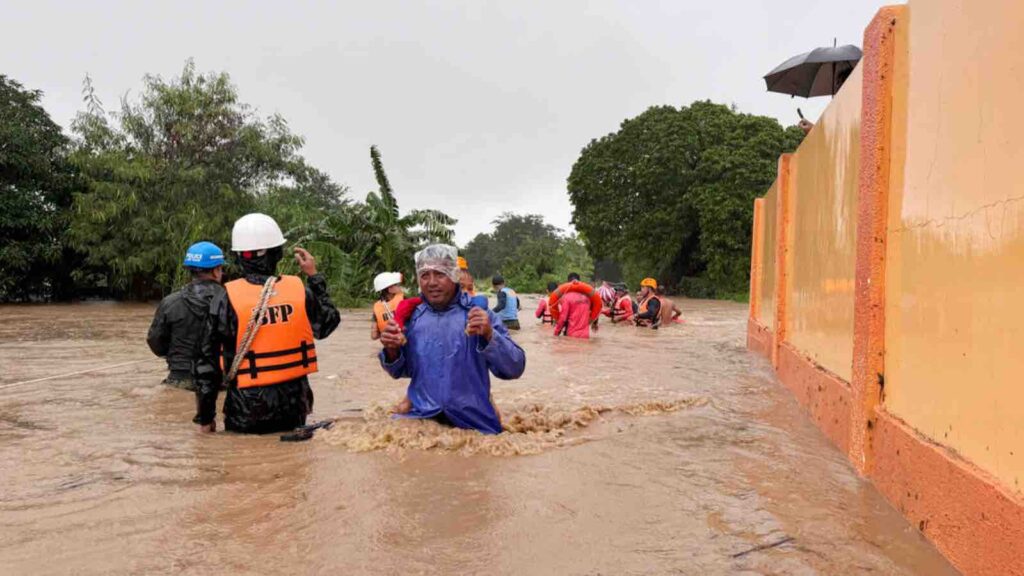Super Typhoon Krathon, one of the most powerful storms to hit Asia this year, has left devastation in its wake across the Philippines and is hitting toward Taiwan.
Super Typhoon Krathon, one of the most powerful storms to hit Asia this year, has left devastation in its wake across the Philippines and is now heading toward Taiwan. The typhoon, with winds reaching a staggering 230 kilometers per hour, has caused widespread flooding, landslides, and destruction in several areas of the northern Philippines.
As Krathon barrels through the South China Sea, Taiwan prepares for landfall, with emergency warnings issued across southern and eastern regions. Schools and businesses have shuttered, and evacuation centers are filling as residents brace for what could be a catastrophic storm.
RELEVANT SUSTAINABLE GOALS




Severe Flooding in the Philippines as Taiwan Braces for Impact
In the Philippines, where the storm is known as Typhoon Julian, the northern island of Luzon has been hit hardest. Photos from the region show residents wading through waist-deep water, their homes submerged, and roads turned into rivers. Strong winds have ripped roofs from homes and uprooted trees, leaving thousands without power.
Batanes Governor Marilou Cayco described the conditions in her province as “feeling like an earthquake,” with many citizens taking refuge in evacuation centers to escape the raging winds and flooding.
Since the start of the week, heavy rains have triggered landslides, especially in rural and mountainous areas, further complicating relief efforts. The Philippine government has mobilized emergency services, but the scale of the damage is vast.
Taiwan Sees Rare Southwest Landfall
As Krathon continues its unpredictable journey, it is expected to make landfall on Taiwan’s southwest coast—a highly unusual event for this time of year. According to Taiwan’s Central Weather Administration (CWA), Typhoon Krathon is the first storm on record to make landfall in Kaohsiung in October.
Forecaster Chang Chun-yao explained that most typhoons in Taiwan strike the eastern coast due to the island’s geographic location. The last storm to hit Kaohsiung was Typhoon Thelma in 1977, which caused widespread destruction. “Krathon’s unusual path highlights the unpredictability of autumn typhoons,” said Chang, adding that the storm’s movements have been difficult to forecast due to shifting wind patterns and its slow speed.
A Growing Threat of Climate-Driven Superstorms
Krathon is the latest in a series of powerful storms that have ravaged Asia in recent months. In July, Typhoon Gaemi devastated parts of Vietnam and the Philippines, and in September, Typhoon Yagi caused widespread damage across Southeast Asia. The increase in frequency and intensity of these storms has raised concerns about the growing impact of climate change on the region.
The devastation caused by Krathon serves as a reminder of how vulnerable Asia is to extreme weather events. The Philippines, in particular, faces an uphill battle as it contends with increasingly severe typhoons each year, with millions of people displaced from their homes and agricultural lands destroyed. For Taiwan, the arrival of Krathon has shattered decades-old patterns, signaling a worrying trend of erratic and more powerful storms.
Krathon has confounded forecasters with its erratic behavior. Initially, the storm was expected to track along Taiwan’s eastern coast. However, as it shifted southward, warnings were revised, placing Kaohsiung directly in its path.
Chang Chun-yao of the CWA noted that the storm had strengthened as it approached Taiwan, with wind speeds reaching 198 kph and gusts of up to 245 kph. The storm stalled just off the coast, weakening slightly before moving inland. By Thursday, Krathon had been downgraded to a tropical storm, but its slow movement continues to bring torrential rains and dangerous winds to Taiwan’s southern cities.
Though Krathon has weakened, the damage it has left behind in both the Philippines and Taiwan is a sobering reminder of the increasing threat posed by superstorms in the Pacific. As climate change accelerates, these once-rare storms are becoming more frequent and more deadly.
You may also be interested in :
Typhoon Bebinca And Super Typhoon Yagi Devastate Asia, Highlighting Growing Climate Vulnerability




